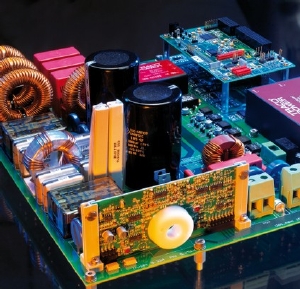Jan 22 2008
A maximum efficiency rating of 98.5 percent for photovoltaic inverters has been achieved by the Fraunhofer Institute for Solar Energy Systems ISE in a test using prototype silicon carbide-based MOSFETs manufactured by CREE, Inc., USA. These are the highest efficiency results reported for photovoltaic inverters to date. Fraunhofer researchers succeeded in reducing the power dissipation of conventional inverters by 30 to 50 percent when compared with results obtained with traditional silicon-based transistors. They are the first researchers worldwide to test the new semiconductor material for this application.
 Inverter circuit board with SiC components
Inverter circuit board with SiC components
Inverters transform direct current generated by photovoltaic systems into alternating current and feed it into the public grid. The higher the efficiency rating of the inverter, the greater is the energy yield of the entire photovoltaic system. To achieve the highest energy output over time, the efficiency rating should remain high over a wide range of power levels. During testing, the inverter with Cree SiC components also set a new performance precedent across a wide range of power output values.
"We are thrilled to have achieved this record level of efficiency. Silicon carbide components switch faster and have a smaller forward bias power loss than traditional silicon-based transistors," says Dr. Bruno Burger, head of the Power Electronics Group at Fraunhofer ISE. Fraunhofer ISE is the first organization known to test silicon carbide MOSFETs in this application. "Our work involved characterizing the components and integrating them into existing inverters. If, in a further step, the inverter circuitry is optimized specifically for silicon carbide, then even greater efficiencies could certainly be achieved."
Currently, the semiconductor silicon carbide SiC is mainly applied in white LEDs, which are presently revolutionizing the lighting technology. SiC diodes have been available for quite a while. However, the MOSFETs (Metal Oxide Semiconductor Field Effect Transistors) which are necessary for the power stage in inverters have not been available until now.
The Fraunhofer team achieved the efficiency rating record with a single-phase inverter with their patent-pending HERIC® topology and a nominal power rating of 5 kilowatts. They also increased the efficiency rating of a three-phase inverter with a nominal power rating of 7 kilowatts from 95.1 to 97.5 percent.
The Fraunhofer Institute for Solar Energy Systems ISE is a leader in the development of photovoltaic inverters. ISE engineers presented the first transformerless inverter 25 years ago and have continued to advance transformerless technology. In the meantime, this technology has now become established in the field of solar power generation. Transformerless inverters are more efficient, cheaper and lighter than devices with transformers.